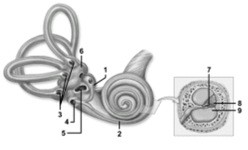The function of the hepatic portal circulation is to ________
A) return glucose to the general circulation when blood sugar is low
B) carry toxins to the kidney for disposal through the urinary tract
C) distribute hormones throughout the body
D) collect absorbed nutrients for metabolic processing in the liver
D
You might also like to view...
Which of the following most accurately describes the renal transport of Na+?
A. Most of the Na+ transport occurs in the distal convoluted tubule and collecting ducts. B. Primary active transport of Na+ allows for secondary active transport of glucose and H+ in the proximal tubule. C. Na+ is actively transported across the luminal membrane of proximal tubule cells in exchange for K+, by Na+/K+ ATPase pumps. D. Na+ is actively secreted into the nephron lumen by cells in the cortical collecting ducts. E. Na+ is actively transported in all segments of the tubule.
 In this illustration of the inner ear, what feature does the number 9 indicate?
In this illustration of the inner ear, what feature does the number 9 indicate?
A. Perilymph B. Endolymph C. Apex of cochlea D. Membranous labyrinth E. Spiral organ
The figure illustrates keratinization in the epidermis. What layer of the epidermis is "A"?
A. stratum granulosum B. stratum lucidum C. stratum spinosum D. stratum basale E. stratum corneum
The coxal joint is a ball-and-socket joint, in which the head of the humerus articulates with the glenoid cavity of the scapula
Indicate whether the statement is true or false